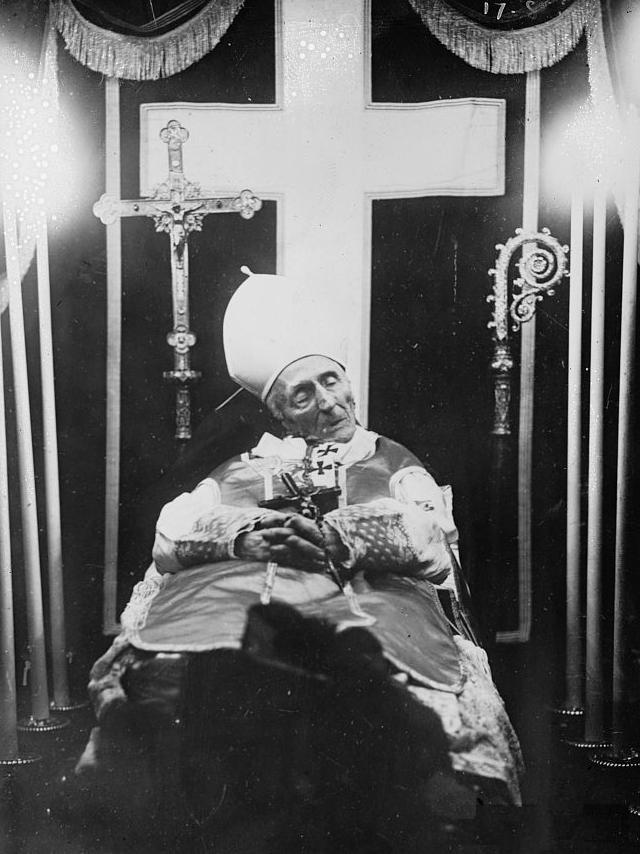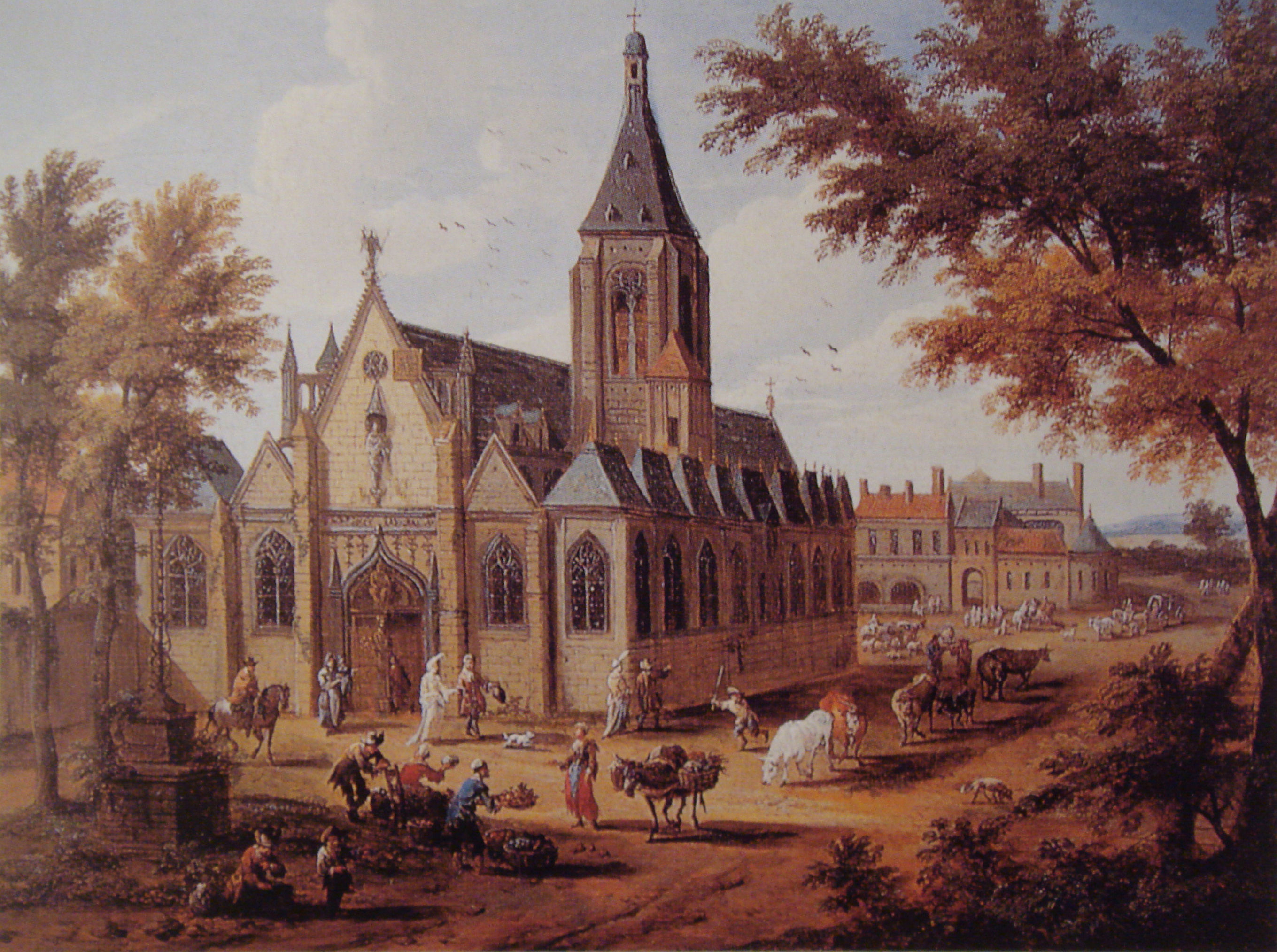|
François-Marie-Benjamin Richard
François-Marie-Benjamin Richard de la Vergne (; 1 March 1819 – 27 January 1908) was a French cardinal of the Roman Catholic Church and served as the Archbishop of Paris. His cause of canonization has commenced and he has the title of Servant of God. Biography Early life and priesthood François-Marie-Benjamin Richard was born in 1819 in Nantes and was one of eleven children. Richard was educated at the seminary of St Sulpice where he studied theology from October 1841. He was ordained to the priesthood on 21 December 1844 by the Archbishop of Paris Denis Auguste Affre. He served as a parish priest from 1845 to 1846 before he was sent to Rome for further studies that spanned from 1846 to 1849. He was later made the Vicar-General of Nantes on 1 August 1850 and occupied that post until 1869. Episcopate Pope Pius IX appointed Richard as the Bishop of Belley on 22 December 1871. He received episcopal consecration on 11 February 1872 in Paris. Later, in 1875, he was appointed T ... [...More Info...] [...Related Items...] OR: [Wikipedia] [Google] [Baidu] |
Servant Of God
"Servant of God" is a title used in the Catholic Church to indicate that an individual is on the first step toward possible canonization as a saint. Terminology The expression "servant of God" appears nine times in the Bible, the first five in the Old Testament, the last four in the New Testament, New. The Hebrew Bible refers to "Moses the servant of Elohim" (עֶֽבֶד הָאֱלֹהִ֛ים ''‘eḇeḏ-hā’ĕlōhîm''; , , , and ). , ). refers to Joshua as ''‘eḇeḏ Yahweh'' (עֶ֣בֶד יְהוָ֑ה). The New Testament also describes Moses in this way in (τοῦ δούλου τοῦ Θεοῦ, ''tou doulou tou Theou''). Paul the Apostle, Paul calls himself "a servant of God" in (δοῦλος Θεοῦ, ''doulos Theou''), while Epistle of James, James calls himself "a servant of God and the Lord Jesus Christ" (θεοῦ καὶ κυρίου Ἰησοῦ χριστοῦ δοῦλος, ''Theou kai Kyriou Iēsou Christou doulos'') in . describes "servants of God" ... [...More Info...] [...Related Items...] OR: [Wikipedia] [Google] [Baidu] |
Église Saint-Sulpice, Paris
, image = Paris Saint-Sulpice Fassade 4-5 A.jpg , image_size = , pushpin map = Paris , pushpin label position = , coordinates = , location = Place Saint-Sulpice 6th arrondissement, Paris , country = France , denomination = Roman Catholic , religious institute = Society of the Priests of Saint Sulpice , website = , bull date = , founded date = , founder = , dedication = Sulpitius the Pious , dedicated date = , consecrated date = , relics = , status = Parish church , functional status = Active , heritage designation = , architect = , style = Baroque , years built = , groundbreaking = 1646 , completed date = 1870 , capacity = , length = , width ... [...More Info...] [...Related Items...] OR: [Wikipedia] [Google] [Baidu] |
Pope Pius X
Pope Pius X ( it, Pio X; born Giuseppe Melchiorre Sarto; 2 June 1835 – 20 August 1914) was head of the Catholic Church from 4 August 1903 to his death in August 1914. Pius X is known for vigorously opposing modernist interpretations of Catholic doctrine, and for promoting liturgical reforms and scholastic theology. He initiated the preparation of the 1917 Code of Canon Law, the first comprehensive and systemic work of its kind. He is venerated as a saint in the Catholic Church and is the namesake of the traditionalist Catholic Priestly Fraternity of Saint Pius X. Pius X was devoted to the Blessed Virgin Mary under the title of Our Lady of Confidence; while his papal encyclical '' Ad diem illum'' took on a sense of renewal that was reflected in the motto of his pontificate. He advanced the Liturgical Movement by formulating the principle of ''participatio actuosa'' (active participation of the faithful) in his motu proprio, ''Tra le sollecitudini'' (1903). He encouraged ... [...More Info...] [...Related Items...] OR: [Wikipedia] [Google] [Baidu] |
Papal Conclave, 1903
The 1903 papal conclave followed the death of Pope Leo XIII after a reign of 25 years. Some 62 cardinals participated in the balloting. Emperor Franz Joseph of Austria asserted the right claimed by certain Catholic rulers to Jus exclusivae, veto a candidate for the papacy, blocking the election of the leading candidate, Cardinal Secretary of State Mariano Rampolla. On the morning of the fifth day, on its seventh ballot, the conclave elected Cardinal Giuseppe Melchiorre Sarto, who took the name ''Pius X''. Background The pope, pontificate of Pope Leo XIII, Leo XIII came to an end on 20 July 1903 after 25 years, longer than any previous elected Pope, except his predecessor Pope Pius IX, Pius IX; together, they had reigned 57 years. While Pius had been a conservative reactionary, Leo had been seen as a liberal, certainly in comparison with his predecessor. As cardinals gathered, the key question was whether a pope would be chosen who would continue Leo's policies or return to the st ... [...More Info...] [...Related Items...] OR: [Wikipedia] [Google] [Baidu] |
Ultramontanes
Ultramontanism is a clerical political conception within the Catholic Church that places strong emphasis on the prerogatives and powers of the Pope. It contrasts with Gallicanism, the belief that popular civil authority—often represented by the monarch's or state's authority—over the Church is comparable to that of the Pope. History The term descends from the Middle Ages, when a non-Italian pope was said to be ''papa ultramontano –'' a pope from beyond the mountains (the Alps).Benigni, Umberto. "Ultramontanism." The Catholic Encyclopedia Vol. 15. New York: Robert Appleton Company, 1912. 6 January 2019 Foreign students at medieval Italian universities also were referred to as ''ultramontani''. After the [...More Info...] [...Related Items...] OR: [Wikipedia] [Google] [Baidu] |
Assumptionist Fathers
The Assumptionists, officialy named the Congregation of the Augustinians of the Assumption ( la, Congregatio Augustinianorum ab Assumptione) abbreviated AA,is a Catholic clerical religious congregation of Pontifical Right for men (priests and brothers). It is active in many countries. The French branch played a major role in French political and social history in the 19th century. Founder Emmanuel d'Alzon Born in Le Vigan on August 30, 1810, Emmanuel d'Alzon received his initial formation in the major seminary of Montpellier (1832–1833) which he completed in Rome. A student of Félicité de Lamennais, he broke with his former mentor but remained influenced by several of his ideas. He launched numerous pastoral initiatives in the diocese of Nîmes under successive bishops : Claude Petit Benoit de Chaffoy (1822–1835), Jean-François-Marie Cart (1837–1855), Claude-Henri Plantier (1855–1875), and François-Nicolas Besson (1875–1878). D'Alzon founded ... [...More Info...] [...Related Items...] OR: [Wikipedia] [Google] [Baidu] |
Joseph Hippolyte Guibert
Joseph-Hippolyte Guibert (1802, Aix-en-Provence, Bouches-du-Rhône – 1886, Paris) was a French Catholic Archbishop of Paris and Cardinal. He was consecrated by Eugène de Mazenod and was appointed by Pope Gregory XVI as bishop of Viviers in 1842, and archbishop of Tours The Roman Catholic Archdiocese of Tours (Latin: ''Archidioecesis Turonensis''; French: ''Archidiocèse de Tours'') is an archdiocese of the Latin Rite of the Roman Catholic Church in France. The archdiocese has roots that go back to the 3rd centu ... in 1857. He became Archbishop of Paris in 1871, and a Cardinal in 1873. He participated in the 1878 conclave. References External linksBiography 1802 births 1886 deaths People from Aix-en-Provence 19th-century French cardinals Cardinals created by Pope Pius IX Archbishops of Paris Archbishops of Tours Bishops of Viviers Bishops appointed by Pope Gregory XVI Missionary Oblates of Mary Immaculate {{france-RC-cardinal-stub ... [...More Info...] [...Related Items...] OR: [Wikipedia] [Google] [Baidu] |
Coadjutor
The term coadjutor (or coadiutor, literally "co-assister" in Latin) is a title qualifier indicating that the holder shares the office with another person, with powers equal to the other in all but formal order of precedence. These include: * Coadjutor bishop, or Coadjutor archbishop * Coadjutor vicar, or Coadjutor apostolic vicar * Coadjutor eparch, or Coadjutor archeparch * Coadjutor exarch, or Coadjutor apostolic exarch Overview The office is ancient. "Coadjutor", in the 1883 ''Catholic Dictionary'', says: Another source identifies three kinds of coadjutors: :(1) Temporal and revocable. :(2) Perpetual and irrevocable. :(3) Perpetual, with the right of future succession.''The Law of the Church: A Cyclopedia of Canon Law for English-speaking Countries'', Ethelred Luke Taunton, 1906, page 204. It describes: See also *Bishop (other) *Vicar (other) *Exarch (other) An exarch was a military governor within the Byzantine Empire and still is a high p ... [...More Info...] [...Related Items...] OR: [Wikipedia] [Google] [Baidu] |
Episcopal Consecration
A bishop is an ordained clergy member who is entrusted with a position of Episcopal polity, authority and oversight in a religious institution. In Christianity, bishops are normally responsible for the governance of dioceses. The role or office of bishop is called episcopacy. Organizationally, several Christian denominations utilize ecclesiastical structures that call for the position of bishops, while other denominations have dispensed with this office, seeing it as a symbol of power. Bishops have also exercised political authority. Traditionally, bishops claim apostolic succession, a direct historical lineage dating back to the original Twelve Apostles or Saint Paul. The bishops are by doctrine understood as those who possess the full Priest#Christianity, priesthood given by Jesus in Christianity, Jesus Christ, and therefore may ordain other clergy, including other bishops. A person ordained as a deacon, priest (i.e. presbyter), and then bishop is understood to hold the fulln ... [...More Info...] [...Related Items...] OR: [Wikipedia] [Google] [Baidu] |
Pope Pius IX
Pope Pius IX ( it, Pio IX, ''Pio Nono''; born Giovanni Maria Mastai Ferretti; 13 May 1792 – 7 February 1878) was head of the Catholic Church from 1846 to 1878, the longest verified papal reign. He was notable for convoking the First Vatican Council in 1868 and for permanently losing control of the Papal States in 1870 to the Kingdom of Italy. Thereafter he refused to leave Vatican City, declaring himself a " prisoner of the Vatican". At the time of his election, he was seen as a champion of liberalism and reform, but the Revolutions of 1848 decisively reversed his policies. Upon the assassination of his Prime Minister Rossi, Pius escaped Rome and excommunicated all participants in the short-lived Roman Republic. After its suppression by the French army and his return in 1850, his policies and doctrinal pronouncements became increasingly conservative, seeking to stem the revolutionary tide. In his 1849 encyclical '' Ubi primum'', he emphasized Mary's role in salvation. In 1 ... [...More Info...] [...Related Items...] OR: [Wikipedia] [Google] [Baidu] |
Rome
, established_title = Founded , established_date = 753 BC , founder = King Romulus (legendary) , image_map = Map of comune of Rome (metropolitan city of Capital Rome, region Lazio, Italy).svg , map_caption = The territory of the ''comune'' (''Roma Capitale'', in red) inside the Metropolitan City of Rome (''Città Metropolitana di Roma'', in yellow). The white spot in the centre is Vatican City. , pushpin_map = Italy#Europe , pushpin_map_caption = Location within Italy##Location within Europe , pushpin_relief = yes , coordinates = , coor_pinpoint = , subdivision_type = Country , subdivision_name = Italy , subdivision_type2 = Region , subdivision_name2 = Lazio , subdivision_type3 = Metropolitan city , subdivision_name3 = Rome Capital , government_footnotes= , government_type = Strong Mayor–Council , leader_title2 = Legislature , leader_name2 = Capitoline Assemb ... [...More Info...] [...Related Items...] OR: [Wikipedia] [Google] [Baidu] |




.jpg)
.jpg)


